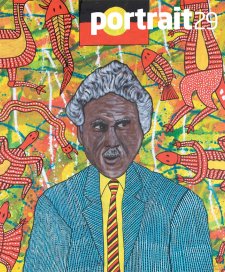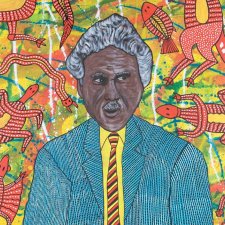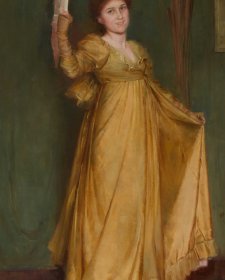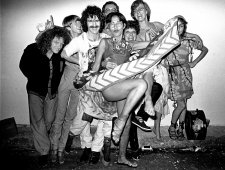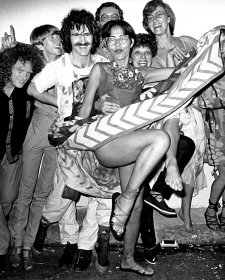In the months leading up to the opening of the new National Portrait Gallery, the curatorial team has been working to select portraits from the collection for the inaugural shows, to secure loans for exhibition and to create new publications, brochures and captions to complement works on display.
When a new commission arrives in the Gallery, however, the curators drop everything to take a first look at a work that they have previously only imagined. Much anticipated, the photograph of Layne Beachley by Sydney photographer Petrina Hicks attracted a cluster of excited Gallery staff when it was delivered in July. Arresting in itself, the portrait is also the harbinger of a suite of freshly commissioned works that visitors to the brand-new premises on King Edward Terrace to the will see for the first time from December.
The oft-photographed Layne Beachley (b. 1972) is the world’s most successful female professional surfer. As a girl growing up in the Sydney coastal suburb of Manly, Beachley excelled in several sports, but at the age of sixteen she made her fateful choice: she would focus on surfing. With a negligible amateur record, she turned professional in 1989, and by the time she was twenty she was ranked number six in the world. Over the course of the 1990s she ploughed on with her training regime through debilitating illness and depression to triumph at the World Championship in 1998. She won consecutive World Championships over the next five years, between 1999 and 2003, and took an incredible seventh title in 2006, her seventeenth year on the tour. Her other women’s surfing records include riding the biggest wave ever, gaining the most world championship tour victories (twenty-nine) and earning the most money on the circuit. In 2003, when she was Australian Female Athlete of the Year, she founded the Aim for the Stars Foundation for the academic, community and cultural improvement of young Australian women. The following year, she was included on the list of Australia’s Most Beautiful Exports. She was inducted into the usaSurfers’ Hall of Fame and earned a stone on the Huntington Beach Surfing Walk of Fame in 2006. That year, she initiated the richest event in women’s surfing history, the Havaianas Beachley Classic at Manly. A thriving businesswoman as well as an athlete, Beachley now promotes her signature line of active wear, often the dazzlingly smiling star of her own photo shoots. At the same time, she is much in demand as an effervescent speaker and ambassador for various charities and causes including the National Breast Cancer Foundation, unicef and Planet Ark.
Petrina Hicks, Beachley’s exact contemporary, also grew up in Sydney, in the suburb of Lugarno on the Georges River. After completing a degree in communications at the University of Canberra she pursued the interest she had there developed in photography, studying further at the Australian National University School of Art. While earning a living as a commercial photography assistant in Sydney for five years, working with advertising, fashion and portrait photographers, she maintained a private focus on her art photography, and entered various art prizes and exhibitions. In 2003, she won both the Fisher’s Ghost Art Award for Contemporary Art in the City of Campbelltown, and the Josephine Ulrick Photography Award for Portraiture in Tweed Heads. Since then, she has been making series of photographs of individuals that strain the definition of portraiture, finding, it has been said, ‘beauty in perceived imperfections and render[ing] idealised beauty strange’. Although she only had her first exhibition with Sydney’s inner-city Stills Gallery in 2005, National Portrait Gallery senior curator Michael Desmond was quick to pick up on Hicks’s work and included a series of her immaculate, unsettling photographs in the National Portrait Gallery exhibition Truth and Likeness in 2006 – 2007, choosing one shot, Lauren in Red 2003 as the leading image for the show.
Commissioned to portray Layne Beachley, Petrina Hicks said that she chose to make a stark representation of the champion as she ‘wanted her eyes to be the central focus … I realised these were where all her strength is revealed.’ She explains that in creating a portrait focusing on the sitter’s eyes, the photographer has to do everything she can to encourage trust. ‘It’s very much a collaboration between sitter and photographer. It takes some time before people are willing and comfortable to bare themselves like this,’ she says. During the shoot in Hicks’s Bondi apartment, the two women had to establish a workable rapport over the space of just a few hours, but Beachley turned out to be ‘lovely’ to work with, and ‘very patient’. Recalling their conversation, Hicks said that one thing Beachley told her about her life in the water struck her with particular force – a remark to the effect that while ‘whales look you right in the eye, sharks stare straight through you’.
If it is an instant of unalloyed enjoyment for Gallery staff to see a commission uncovered, it is likely to be a more equivocal moment for the subject, who may well see herself revealed – for better or worse – in an entirely unfamiliar way. Layne Beachley has often been captured on film, in the ocean, emerging from it with dripping bikini and board or brandishing a trophy at the close of an event. However, she had never before been photographed so intimately, or with such scrutiny. ‘I was honestly astounded when I first opened the photo,’ she wrote to Michael Desmond. ‘It’s quite intensely stunning and provoking all at once. I look so focused and at peace at the same time. Truly remarkable.’ Beachley paid tribute to the contribution of her partner, Kirk Pengilly, to the portrait, in so far as she believes the finished result clearly reflects what she was thinking about during the hours of posing - the ‘warmth and security’ she finds in his embrace.
The photograph of Layne Beachley is an especially pleasing addition to the holdings of the Gallery because both its sitter and its artist are young women, who for various reasons are something of a rarity in the collection. Beachley and Hicks each approached the shoot with only theoretical knowledge of the other’s strengths. The success of their session together, however, is testament to the professionalism of each, as the fierce competitor drew necessary confidence from the pale, petite photographer’s unswerving focus on achieving the image she had envisaged. Until it is publicly unveiled in a few months’ time, the last word on the commission will rest with Beachley, who states that she is ‘really proud and honoured to be shot and hung in the National Portrait Gallery’.



